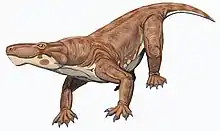Pristerognathus
Pristerognathus is an extinct genus of therocephalian, known from the late Middle Permian (Capitanian) of South Africa.[1] It lends its name to the Pristerognathus Assemblage Zone of the Beaufort Group of South African geological strata. Pristerognathus was a medium-sized therocephalian with a 25 cm (9.8 in) skull and a total length up to 1.5 m (4 ft 11 in).[2]
| Pristerognathus Temporal range: Middle Permian | |
|---|---|
 | |
| Restoration of two P. vanderbyli | |
| Scientific classification | |
| Kingdom: | Animalia |
| Phylum: | Chordata |
| Clade: | Therapsida |
| Suborder: | †Therocephalia |
| Family: | †Scylacosauridae |
| Genus: | †Pristerognathus Seeley, 1895 |
These animals were roughly dog-sized, and are characterized by long, narrow skulls with large canines. They are likely to have lived in woodlands, and preyed on smaller therapsids and millerettids of the time.[3]
Pristerognathus was discovered in 1895 by Seeley. Three species are known: P. baini, P. polyodon and P. vanderbyli.[4] There has also been a fourth species P. minor, but this has been reclassified to Pristerognathoides.
See also
References
| Wikimedia Commons has media related to Pristerognathus. |
- F. Abdala, B. Rubidge, and J. van der Heever, "The oldest therocephalians (Therapsida, Eutheriodonta) and the early diversification of Therapsida," Palaeontology, 51, 1011-1024 (2008)
- Stainford Kemp, Thomas(2005) The origin and evolution of mammals p.55
- http://dinosaurs.about.com/od/predinosaurreptiles/p/pristerognathus.htm
- http://www.paleofile.com/Theriodontia/Pristerognathus.asp



